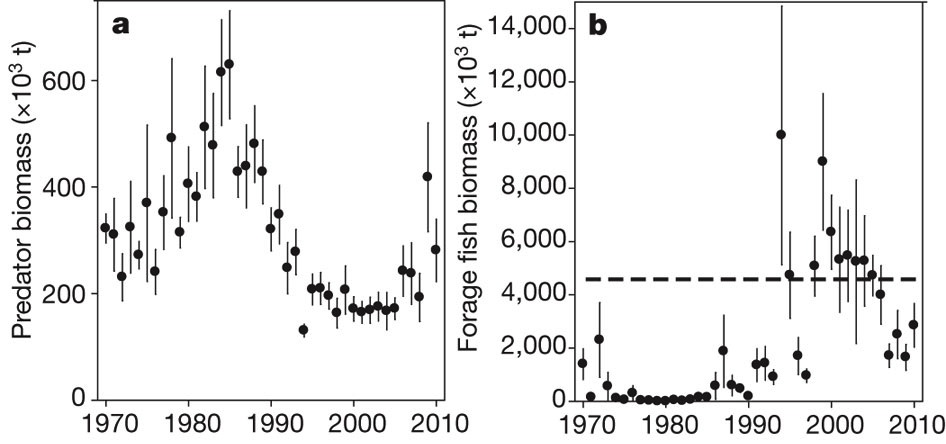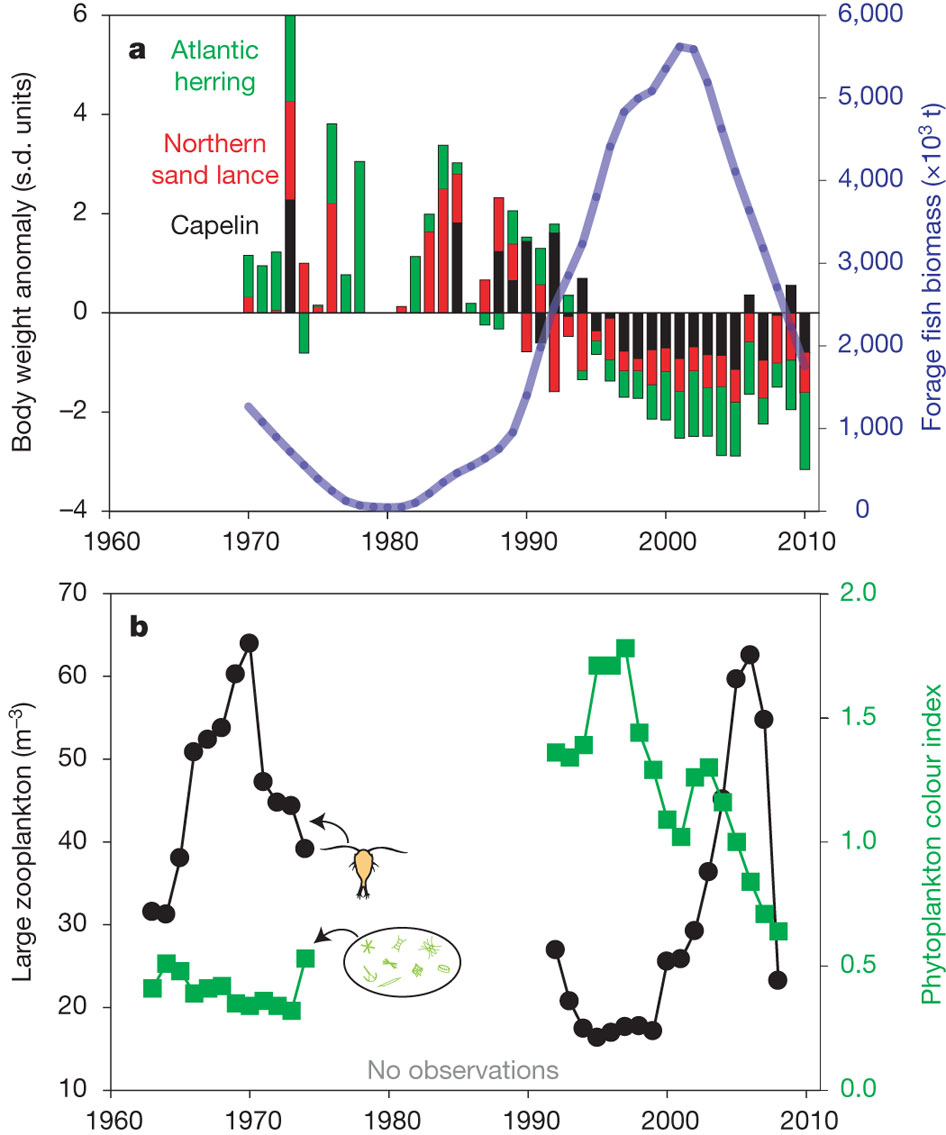These are the lecture notes from the second lecture of my Marine Ecology course (BIOL 462) at UNC last fall. The first lecture is here.
Required readings for this lecture: A recent article by Dr. Emmett Duffy about the hints of a Cod recovery in the north Atlantic and the scientific paper (in Nature) it was based on (here). Also read another article by Dr. Duffy here about decapitated ecosystems here based on this paper in Science. Don’t know anything about cod? Then go here.
The Gulf of Maine Cod Fishery: Then and Now

Compensation in exploited fish communities
Compensatory increases in species initially not targeted are common but are often reversed within a decade (once they are targeted)
An example from pelagic billfish:
Georges Bank cod recovery? possible causes and indirect effects
(a) Large benthic fish, including cod. (b) “forage fishes”, with estimated carrying capacity shown as dashed line.
A role for or effect on plankton and planktivores?
(a) Body weight anomalies (bars) and biomass (solid line) of forage fishes.
(b) Time trends of large zooplankton abundance and phytoplankton abundance.
Other explanations? Perhaps this?
Cascading effects of overfishing: the lobster fishery is enhanced! (a top down effect)
A bottom up explanation for the observed increase in lobster abundances
go here to read more about this work from Win Watson’s lab at UNH and here to read a recent NYT story about the Maine lobster fishery
Cascading effects of overfishing: cod, lobster, urchins and kelp
Changes in the trophic structure of the GOM food web
Trophic skew
From Byrnes et al 2007 here and go here if you forget what a food web is
Trophic levels in a marine food web
Changes in the composition of marine (and other) food webs includes both extinctions and invasions (subtractions and additions), but these tend to be species at different trophic levels:
You can combine these changes to estimate skew:
But who is invading and going extinct can vary from place to place, eg (from Bruno and Cardinale 2008);
Cascading effects of overfishing: Megafaunal collapse in the North Pacific as a result of intense whaling?
“Fishing Down the Food Chain” Concept
- Published in 1998, Pauley et al. used Food and Agriculture Organization (FAO) landing data to demonstrate the ‘”fishing down the food chain” effect (see above)
- MTL (mean trophic level) was main indicator used to stake claim of fishing down food chain at global level. Primary producers attributed a value of 1 and top carnivores attributed a value of 4.6
- Study showed that the trophic level of fish landings has significantly declined over the last 2 decades.
Zooarchaeology: Ecological Patterns from the Past
Reduction in fish size, probably due to fishing pressure, between 2000 and 500 YPB (years before present) (See Wing and Wing 2001)
In many systems, overfishing may have begun thousands of years ago (see Wing and Wing 2001)
Cascading effects of the loss of top predators
Ecological impacts of size selection by fisheries
Effects of bottom trawling on benthic communities
- A fishery that targets bottom fish and invertebrates (e.g., Cod and scallops)
- Dramatically reduces structural complexity in an environmental where disturbance is normally infrequent
- Habitat forming species are removed and can take decades to centuries to recovery (due to very low growth and recruitment rates)
- Has largely replaced long line fishing in the Gulf Of Maine
- 14.8 million km2 or 53% of the worlds continental shelf is swept annually
- an area 150 times larger than deforestation
Bottom trawling – the method of choice for catching bottom fish in New England – is highly destructive. The method essentially entails dragging a weighted net across the sea floor; it is effective, but catches and kills indiscriminately and also destroys essential fish habitat (imagine cutting down a forest to catch a squirrel).
[youtube]http://www.youtube.com/watch?v=bUHcD_jTgVA&[/youtube]
Fisheries bycatch
- www.bycatch.org : A searchable database of references and summaries from bycatch reduction studies, as well as descriptions of bycatch mitigation techniques
- Worldwide about 27 million tons of fish, mammals, turtles, birds, and invertebrates are discarded in bycatch each year
- Bycatch is a polite term for species, i.e.,animals, that are accidentally caught and then thrown overboard usually after they sufficate on deck. In some fisheries, the ratio of bycatch to catch (of targeted species that are kept) can be 10:1 or higher, particular in the wild shrimp fishery where bycatch ratios can reach 20:1 and consist of endangered species like sea turtles. The photo below is the catch from a shrimp trawl; hard to see any shrimp in that pile of flesh isn’t it.






































Leave a Reply